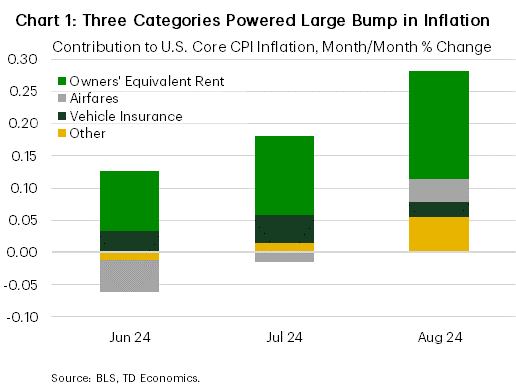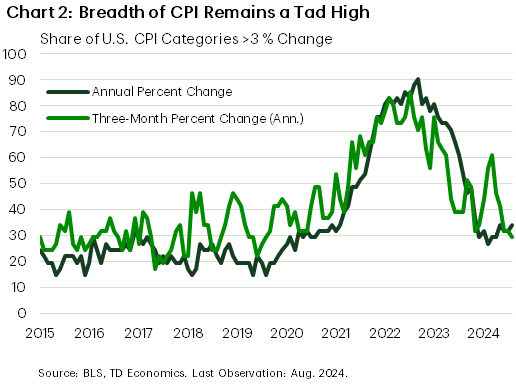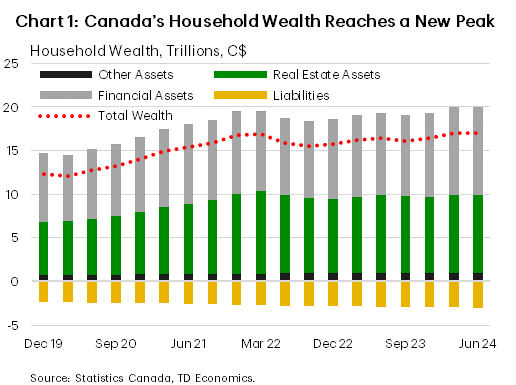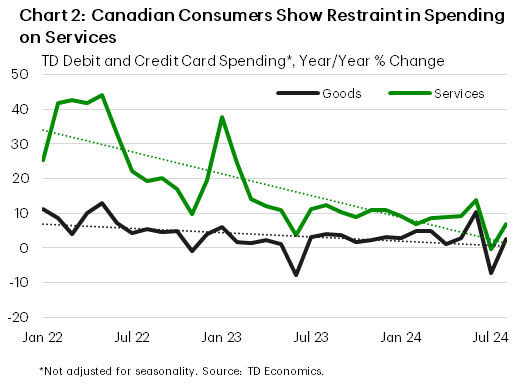U.S. Highlights
- Markets have been weighing the prospect that the Federal Reserve will opt for a 0.5 percentage point cut in the federal funds rate next week.
- Core consumer price index inflation surprised to the upside, lifted by a strong print from owners’ equivalent rent.
- The breadth of inflation continues to gradually narrow, but a still resilient economy supports the case for a standard 0.25 point cut at next week’s Fed meeting.
Canadian Highlights
- Canadian household net worth rose further in the second quarter of 2024, with gains in U.S. equities and deposits offsetting declines in real estate and Canadian equities.
- Consumer spending remains muted. TD Spend data shows spending on services slowing down, now tracking closer to goods spending, as debt servicing costs continue to weigh on household budgets.
- The Bank of Canada is expected to continue its rate-cutting cycle, bringing the policy rate down to 3.75% by year-end. Stay tuned for our updated economic forecast that will be released next Tuesday.
U.S. – Here Comes the Cut
After Vice President Harris and former President Trump took their turn in the spotlight on Tuesday night, focus turned back to inflation and where the Federal Reserve is likely to take interest rates from here. Markets were weighing the possibility that the deteriorating economic backdrop was opening the door to a 50 basis-point cut in the Fed Funds rate next week. Alas, inflation didn’t seem to want to cooperate, as Consumer Price Index (CPI) inflation clocked in at 2.5%, as expected, with the core measure surprising to the upside amid an upturn in shelter prices. Current market pricing puts the odds of a 50 basis-point cut at basically a coin toss, but we think the state of the economy and the details of the report argue for a smaller 25 basis-point move next week.
First, and foremost, this week’s report is a minor setback and not a return to the widespread inflation we saw in 2022. Most of the gain was powered by a strong showing in shelter costs, specifically owners’ equivalent rent (Chart 1). Growth here ticked up for the month, but this has been a steady contributor to inflation this cycle. While the rate could moderate slightly heading into the fall, it was the strongest print in seven months. Now, importantly, the Fed’s preferred measure looks at core personal consumption expenditure (PCE) inflation, where shelter prices carry a smaller weight. So, this upturn will have a comparably smaller impact on the Fed’s preferred inflation measure.
As for the two other major inflationary culprits, airfares and vehicle insurance, there is reason to expect moderation. New and used vehicle prices have cooled substantially, and after rising car valuations drove insurance rates higher, this impulse should continue to fade. On airfares, last month broke a string of negative prints for the category – an element of giveback that could easily fade.
All of which is to say, consumer price inflation is gradually becoming confined to fewer categories (Chart 2). Taking a lens to the three-month percent change of the CPI categories, the share of categories with prices still rising above a three percent (annualized) rate has been below the pre-pandemic average for the past three months. After the uptick in inflation last spring, the return to a downward trajectory is welcome. This trend will need to continue for few more months still before the year-on-year prints start to show the same normalization, but things are pointing in the right direction.
The data suggest that the Fed’s policy rate does not need to be as restrictive as it is, but while former NY Fed President Dudley this week suggested there was “a strong case” for a 50 basis- point cut, we think this is a tad premature. Between this week’s CPI report showing unexpected strength in core consumer prices, the upside surprise in the producer price index, and a labor market that continues to steadily add jobs, there is enough strength to suggest aggressively easing monetary policy is not yet warranted. Our view remains that a 25 basis-point cut next week is the most likely outcome, with two more cuts coming by year-end.
Canada – Spending Restraint Despite Wealth Gains
In the absence of major Canadian economic releases this week, the rates market’s head was turned towards our southern neighbour. Financial markets are leaning slightly towards a standard 0.25 percentage point cut at the Federal Reserve rate decision next Wednesday, but on Friday morning raised the odds of a larger 0.5 point cut to nearly a coin flip. Bond yields continued to trend downward as investors sought to lock in rates. Canada’s 10-year government bond yield fell 10 basis points. Meanwhile, the S&P/TSX index hovered near record highs, buoyed by strength in the resource sector, as gold prices advanced and oil rebounded. The index ended the week 3.7% higher, with a quarter-to-date gain of 8.0%.
Sparse though it was, the week brought forward several second-tier data releases. The national balance sheet and financial flow accounts for the second quarter of this year showed that Canadian household net worth grew by $42.4 billion. That was a relatively modest 0.3% quarter-on-quarter increase, but it built on top of a healthy 3.6% gain in the first quarter. Gains in U.S. equities and deposits more than offset declines in real estate and Canadian equities.
Household wealth growth is expected to accelerate by the end of the current quarter, barring any major disruptions in equity markets, which are tracking in the black on both sides of the border. House prices are also rising, and are expected to finish this quarter strong. Although some regional housing markets, particularly the Greater Toronto Area condo market, face headwinds due to supply-demand imbalances and still-high mortgage rates.
Despite wealth gains, the wealth effect on consumer spending remains muted, as most wealth is concentrated in the top 20% of households who typically have lower propensity to consume. Furthermore, adjusted for inflation and population growth, per capita household wealth has fallen nearly 15% from its 2021 peak. Since then, real per capita spending has contracted in seven of the last 11 quarters, underscoring that on aggregate, economic growth has been largely population-driven rather than productivity led.
Our internal data shows that while consumer spending on services is still chugging along, the pace is noticeably slowing (Chart 2). Services, which had been outpacing goods since 2021, are now tracking much closer to goods spending. Canadians may still have a nest egg—whether in real estate or investments—but they are hesitant to spend freely. With debt servicing costs still taking up 15 cents of every disposable income dollar, it’s no surprise that consumer enthusiasm is tempered.
With services inflation excluding shelter still elevated, a continued slowdown in services spending helps reduce the risk of renewed upward pressure on services prices. This provides peace of mind for the Bank of Canada in sticking with its course. We expect the Bank continue cutting its police rate in October, with another reduction in December, bringing the rate down to 3.75% by year-end. Stay tuned for our updated economic forecast that will be released next Tuesday.
















